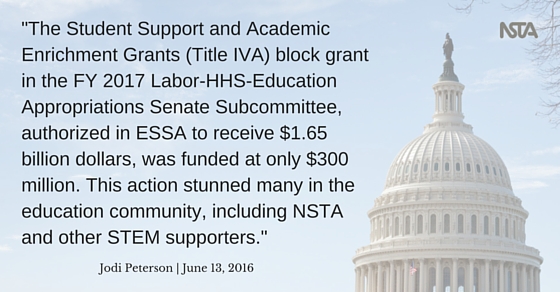Legislative Update
Senate Passes Bill to Fund FY2017 ED Programs
By Jodi Peterson
Posted on 2016-06-13
Senate Passes Bill to Fund FY2017 ED Programs
Its once again appropriations time in the nation’s capital, and this year federal lawmakers are working hard to pass the 12 FY2017 appropriations bills via regular order, instead of resorting to a series of continuing resolutions or relying on one big omnibus bill to fund the government. However, politics may sink this ship once again this year.
Funding for the Departments of Labor, Health and Human Services and Education– including the programs under the new federal education law the Every Student Succeeds Act–or ESSA–was finalized last week by the Senate Appropriations Committee on Thursday, June 9. While the bill did provide a substantial boost to the NIH for combating opiate abuse and Alzheimer’s research, funding for K-12 programs under the Every Student Succeeds Act (ESSA) was dismal.
The Student Support and Academic Enrichment Grants (Title IVA) block grant in the FY 2017 Labor-HHS-Education Appropriations Senate Subcommittee, authorized in ESSA to receive $1.65 billion dollars, was funded at only $300 million. This action stunned many in the education community, including NSTA and other STEM supporters. NSTA and the STEM Education Coalition both issued statements prior to the final vote asking lawmakers to raise the level of funding for the Title IV program. Several other groups, including school counselors, music educators, school technology leaders and physical educators, were equally disappointed with the funding level and also sent similar missives. (Read Education Week reporter Alyson Klein’s article on the Senate’s action and a separate article on the reaction by education advocates.)
As reported in earlier issues of the NSTA Legislative Update, the No Child Left Behind (NCLB) Math and Science Partnerships were consolidated into Title IV in the ESSA Every Student Succeeds Act (known as the Student Success and Academic Enrichment Grant). Every district would get funding from this grant to use in a variety of ways to provide students with a well-rounded education, support student health and wellness, and expand educational technologies.
Under Title IV districts can elect to use funds to provide students with a well rounded education by improving instruction and student engagement in science, technology, engineering and math (STEM) by expanding high-quality STEM courses; supporting the participation of students in STEM nonprofit competitions; providing hands-on learning opportunities in STEM; integrating other academic subjects, including the arts, into STEM subject programs; creating or enhancing STEM specialty schools; integrating classroom-based and afterschool and informal STEM instruction; and expanding environmental education.
The Senate appropriators also cut Title II A state grants for teacher quality by about $200 million from the current levels of $2.3 billion.
The bill marked the first time in seven years that the committee avoided controversial amendments and voted in bipartisan way for this spending bill.
Focus now turns to the House education appropriators, who are expected to take up their funding bill for the Department of Education in a few weeks.
Flat Funding for FY2017 National Science Foundation Education programs
Overall funding for education in the NSF Education and Human Resources in both the Senate and House committee bills is flat this year. Below is a chart (credit: American Institute of Physics) for the major NSF directorates. Read more here.
FY 2017 NSF Appropriations Summary Table
Department of Education Releases Proposed Regulations for ESSA
Earlier this month ED released for public comment a set of proposed regulations that will provide states with more understanding of the law in three key areas: accountability, data reporting, and consolidated state plans.
The proposed regulations clarify several provisions in ESSA, including how to calculate and assign an overall rating to measure the quality of learning in schools; how to report on and hold schools accountable for the academic performance of students; and when states must intervene and provide support to low-performing schools.
ED will be accepting comments on the draft regulations until August 1, 2016. Draft regulations for assessments and supplement, not supplant are expected to be released in July 2016.
View the proposed regulations, a fact sheet, a chart comparing these proposed regulations to No Child Left Behind (NCLB), and the Department’s press release on the ESSA resources web page. Or read Ed Week’s Cheat Sheet for ESSA Accountability Plans.
What is Your State Doing to Implement ESSA?
And speaking of ESSA, here are examples of how Hawaii, Washington state, Michigan, Alaska, Nevada , Louisiana and Oregon are working to develop state plans to implement the new federal education law. Check out your state’s department of education website to find
out what your state is doing to get ready for ESSA and how teachers can get involved. If you’d like to learn more about the law and how teachers can be a part of this effort (and ensure the science education community and classroom teachers are represented), or if you have questions, email me at jpeterson@nsta.org.
Jodi Peterson is Assistant Executive Director of Legislative Affairs for the National Science Teachers Association (NSTA) and Chair of the STEM Education Coalition. e-mail Peterson at jpeterson@nsta.org; follow her on Twitter at @stemedadvocate.
Follow NSTA
Disclaimer: The views expressed in this blog post are those of the author(s) and do not necessarily reflect the official position of the National Science Teaching Association (NSTA).




